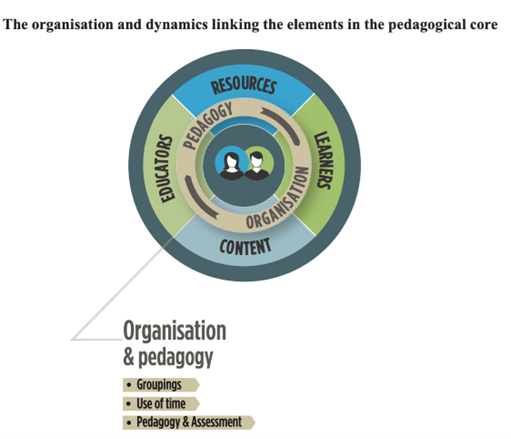This was a real moment of educational innovation. We (students; teachers and parents) hadn’t experienced such a shift in the educational landscape or in our pedagogical practice for decades and although it was a tough start, many schools and educators used this new learning environment to the best of their ability, many skillfully designing learning to suit the new virtual spaces.
It is also true that many educators continue to argue that real innovation happens outside of the building called school and its traditional spaces called classrooms. The questions that have been asked for a while are as follows: What is the impact of the physical environment on learning? How can we organize our learning spaces to stimulate and enhance learning? How can we provide authentic spaces for our students to learn? How can we shape the learning environments to support our learners’ experiences?
“Aside from sleeping, and perhaps playing, there is no other activity which occupies as much of a child’s time as that involved in attending school. Apart from the bedroom where he has his eyes closed (most of the time) there is no single enclosure in which he spends a longer time than he does in the classroom” [1]
Previously, research undertaken on learning environments revealed a number of key aspects believed to support the learning experience of the students. Sanoff (2001) [2] created a classroom rating system highlighting pedagogical elements that play a significant role such as space so students can move freely; flexible areas that can be easily identified; opportunities to work both independently and collaboratively; areas designed to specifically promote collaboration; team- teaching (more than one expert in the room – a guide on the side) all of which combine to enhance learning.
Wolff (2002) [3] similarly identified 22 design features that appeared to have a positive impact on learning and more specifically project-based learning, similar to those previously identified by Sanof.
These are:
• A variety of learning zones for individual and group work
• Presentation areas
• ‘Cave’ Spaces
• Galleries • Labs
• Display areas
• Access to technology
The research also intimated that financial investment in the physical environment and making visible improvements made that learners feel ‘valued’; that they were being invested in and their learning and what they were doing had significance. This is particularly true where learning environments are viewed as contemporary or cutting edge, it signals a change for the better and that ‘something new, different or unique is happening here.’ The study by Price Waterhouse Cooper (2000) [4] confirmed that there is a relationship between capital investment and student performance.
‘For potential truants, a comparison can be made between the comfort and quality of the school surroundings and those of the local shopping mall – all too often the mall was far superior.’(p162; OECD) [5]
A colleague of mine often referred to his vision of ‘the shopping mall of learning’ when he was building his first new school – he totally understood the complexity and psychology involved in creating a successful and holistic ‘learning environment’, attractive, inviting and motivating those inside it.
In our new vision of education, there is a desire to reproduce across the whole school, the free-flow, play-based approaches prevalent in early years education. These elements contribute to the efficacy of the learning environment and to the development of the knowledge, skills and competencies that particular environments can promote in learners. The idea that replicating a workplace setting – whether a technical workshop or a Google -type workspace, can have a significant impact in terms of connecting knowledge and practice, is certainly not new.
‘We know that there is a link between pedagogical practices and spatial settings.
’ But too often educators resist the opportunity to move from what they see as their own familiar classroom to a ‘new’ area or new environment. It’s just easier for them to stay put.
‘How many educators are comfortable in their space - their classroom, identifying it as ‘mine’, often unwilling to share, to move elsewhere which is wholly inconvenient?’ (Dudek; 2000; p55) [6]
More recent studies (OECD; Report on Innovative Learning Environments) [7] focus on the learning environment as a ‘holistic’ concept, one that encompasses the learners, educators, content and resources accompanied by the view that these four aspects need to be re-considered. OECD calls this ‘The Pedagogical Core’.(see Fig.1 below). Additionally, there are a variety of criteria that must all be fulfilled to holistically define an innovative learning environment appropriately.

The criteria are listed below:
• No.1 - learning and engagement are central
• Learning is social and collaborative
• the learner’s emotions and motivations are clear
• is aware of each learner’s individual differences
• learners are challenged
• activities are marked by formative assessment
• the activities take place across subject boundaries
With the emphasis on personalised learning; the development of the desired skills; high student agency and engagement; use of innovative resources; a change to the traditional roles of teacher and student, with a view to enhancing the learning experience are all part of ‘the learning environment.’
At Citizens, the learning environments, in fact, the whole school, has been designed around these ideas- the cutting-edge Google- style workplace; the Smart school; space and progressive furniture design to entice the people in the space and to enhance learning.
But we all appreciate that it is so much more than the physical spaces where educators and their learners spend their time and the real key to the learning environment: the learning that is taking place in space every day.
Bibliography
1. Jackson, P. W. (1998): Life in the Classroom. New York, pp. 5
2. Sanoff, H. (2001), “School Buildings Assessment Methods”, North Carolina State University and OECD/PEB Evaluating Quality in Educational Facilities 2005 167 National Clearinghouse for Educational Facilities, Washington, D.C.
3. Wolff, S. (2002), Design Features for Project-Based Learning, Oregon State University.
4. PriceWaterHouseCoopers (2000), “Building Performance: An Empirical Assessment of the Relationship between Schools Capital Investment and Pupil Performance“, Department for Education and Skills, United Kingdom.
5. OECD (2013) Innovative Learning Environments; Educational Research and Innovation. OECD Publishing
6. Dudek M., (2000): Architecture of Schools: the New Learning Environments, Oxford, AP
7. Fisher, K (2005) Research into Identifying Effective Learning Environments. OECD/PEB
Author: Tracy Moxley, Executive Principal at Citizen's School
Tracy's Linkedin : https://www.linkedin.com/in/tracymoxley/
You Can Visit Citizen's School here: https://citizens.me/

